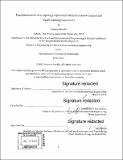| dc.contributor.advisor | Josephine V. Carstensen. | en_US |
| dc.contributor.author | Novillo, Andrew. | en_US |
| dc.contributor.other | Massachusetts Institute of Technology. Department of Civil and Environmental Engineering. | en_US |
| dc.date.accessioned | 2020-01-08T19:44:16Z | |
| dc.date.available | 2020-01-08T19:44:16Z | |
| dc.date.copyright | 2019 | en_US |
| dc.date.issued | 2019 | en_US |
| dc.identifier.uri | https://hdl.handle.net/1721.1/123422 | |
| dc.description | Thesis: M. Eng., Massachusetts Institute of Technology, Department of Civil and Environmental Engineering, 2019 | en_US |
| dc.description | Cataloged from PDF version of thesis. | en_US |
| dc.description | Includes bibliographical references (page 61). | en_US |
| dc.description.abstract | Topology optimization has only begun to emerge into the building industry because of the lack of testing being conducted to evaluate its performance. Within the civil engineering field, topology-optimized designs have to date mainly been produced as a proof of concept rather than for load testing. The hybridization of topology optimization and manufacturing presents an opportunity for the techniques to inform each other throughout the design process. This thesis proposes a study aiming to bridge the gap across disciplines by designing a topology-optimized building connection, finding an effective method to fabricate the design, and experimentally load-testing its behavior to verify the performance results. A roof truss connection is chosen from the Scottish Parliament in Edinburgh, as it is a unique node joining eight elements from an unordinary truss. Abaqus with Tosca is then used to perform the topology optimization. | en_US |
| dc.description.abstract | An elastic continuum design is set up using the Tosca engine with a density-based approach. The specified objective for the test is minimization of the global compliance, which corresponds to a maximized stiffness of the connection, subject to a varying volume constraint and casting constraints. The connections are then investment cast out of aluminum in the MIT foundry. The conventional casting process incorporates 3D printing to help create the free-form geometries of the optimization. The complex load case of the connection requires a custom testing frame to be built to simulate the roof truss. There are many challenges associated with testing physical specimens in the field of structural engineering. In this work, it was found that the casted material contains imperfections that affects the experimentation results. While the experimental results are not directly comparable to the numerical predictions, the specimens themselves are comparable. | en_US |
| dc.description.abstract | The original connection appeared as the strongest specimen in the experimentation for ultimate loads, had the highest stiffness, and lowest compliance. This experiment shows how sensitive optimization is to material properties, boundary conditions, casting process, and volume constraints. This study provides the framework for creating an optimized connection that performs the same in physical experimentation as it does computationally. | en_US |
| dc.description.statementofresponsibility | by Andrew Novillo. | en_US |
| dc.format.extent | 61 pages | en_US |
| dc.language.iso | eng | en_US |
| dc.publisher | Massachusetts Institute of Technology | en_US |
| dc.rights | MIT theses are protected by copyright. They may be viewed, downloaded, or printed from this source but further reproduction or distribution in any format is prohibited without written permission. | en_US |
| dc.rights.uri | http://dspace.mit.edu/handle/1721.1/7582 | en_US |
| dc.subject | Civil and Environmental Engineering. | en_US |
| dc.title | Experimentation of a topology-optimized metal structural connection under casting constraints | en_US |
| dc.type | Thesis | en_US |
| dc.description.degree | M. Eng. | en_US |
| dc.contributor.department | Massachusetts Institute of Technology. Department of Civil and Environmental Engineering | en_US |
| dc.identifier.oclc | 1135054784 | en_US |
| dc.description.collection | M.Eng. Massachusetts Institute of Technology, Department of Civil and Environmental Engineering | en_US |
| dspace.imported | 2020-01-08T19:44:15Z | en_US |
| mit.thesis.degree | Master | en_US |
| mit.thesis.department | CivEng | en_US |
